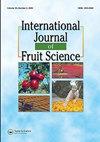Optimization of Low-cost Drying Technology for Preservation of Peach (Prunus Persica) Using RSM
IF 2.4
3区 农林科学
Q2 HORTICULTURE
引用次数: 3
Abstract
ABSTRACT Peach is an important fruit; however, its perishability limits its availability to the consumers. The present study fosters a low-cost preservation method of peach involving osmotic dehydration at 35–45◦C using a sugar solution (50–70◦Brix) for 60–180 minutes. The conditions for osmotic dehydration (OD) of peach slices in terms of maximum water loss (WL), rehydration ratio (RR), minimum solute gain (SG) with optimum hardness, and maximum overall acceptability (OA) were optimized using Box-Behnken Design (BBD) of response surface methodology (RSM). The regression coefficient of the models indicated that the time of immersion was the most significant (p < .001) factor for WL and SG, followed by the temperature. Furthermore, immersion time had a positive effect on hardness, whereas it had a negative effect on the organoleptic properties of osmo-dried peach slices. Sucrose concentration of 63.20◦Brix for 133 minutes at 41◦C was most suitable for osmotic dehydration of peach slices to obtain maximum possible WL, minimum SG, maximum RR, optimum hardness, and maximum overall acceptability. Combined drying (OD+CAD) significantly reduced the drying time and had better retention of sensory attributes. The peach slices subjected to a combination of OD+CAD had good retention (45–50%) of bioactive components even at ambient temperature and had an overall acceptability score of above 6.0 with a 6-months shelf life of the product. The technology was demonstrated among the small-scale processors and entrepreneurs and based on the response received, more than 90% highly rated this technique as efficient, energy-conserving, and easy to adopt.RSM法优化桃果保鲜低成本干燥工艺
桃是一种重要的水果;然而,它的易腐性限制了它对消费者的可用性。本研究培养了一种低成本的桃子保存方法,包括在35-45°C下使用糖溶液(50-70°白利度)渗透脱水60-180分钟。采用响应面法(RSM)的Box-Behnken设计(BBD),从最大失水率(WL)、复水率(RR)、最佳硬度下最小溶质增益(SG)和最大总体可接受度(OA)等方面对桃片的渗透脱水条件进行了优化。模型的回归系数表明,浸泡时间是WL和SG最显著的影响因素(p < 0.001),其次是温度。浸渍时间对桃片的硬度有正向影响,而对桃片的感官特性有负向影响。蔗糖浓度为63.20◦Brix, 41◦C, 133分钟最适合于桃片的渗透脱水,以获得最大可能的WL,最小SG,最大RR,最佳硬度和最大的整体可接受性。OD+CAD联合干燥显著缩短了干燥时间,并具有较好的感官属性保留效果。经OD+CAD组合处理的桃片,即使在常温下,生物活性成分的保留率也保持良好(45-50%),总体可接受评分在6.0以上,产品保质期为6个月。该技术在小型加工商和企业家中进行了演示,根据收到的反馈,90%以上的人高度评价该技术高效、节能和易于采用。
本文章由计算机程序翻译,如有差异,请以英文原文为准。
求助全文
约1分钟内获得全文
求助全文
来源期刊

International Journal of Fruit Science
Agricultural and Biological Sciences-Agronomy and Crop Science
CiteScore
6.40
自引率
0.00%
发文量
64
审稿时长
10 weeks
期刊介绍:
The International Journal of Fruit Science disseminates results of current research that are immediately applicable to the grower, extension agent, and educator in a useful, legitimate, and scientific format. The focus of the journal is on new technologies and innovative approaches to the management and marketing of all types of fruits. It provides practical and fundamental information necessary for the superior growth and quality of fruit crops.
This journal examines fruit growing from a wide range of aspects, including:
-genetics and breeding
-pruning and training
-entomology, plant pathology, and weed science
-physiology and cultural practices
-marketing and economics
-fruit production, harvesting, and postharvest
 求助内容:
求助内容: 应助结果提醒方式:
应助结果提醒方式:


